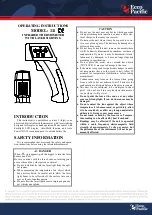
Contact your network administrator if you require further assistance in
implementing secure access.
Two-Factor Authentication is an authentication using a combination of two
different and independent paths. The user is checked by the remote station
and the remote station is checked by the user.
In the case of LAUDA, a user with automatically generated access data is
created in the constant temperature equipment during the 2FA. The access
data is stored in the App in the form of a token and as a cookie in the web
browser. The token is valid for 6 months. In addition to this, all registered
users (tokens) can be deleted via the Master on the constant temperature
equipment. The user must repeat the 2FA in these cases.
The 2FA must be performed:
n
At the first connection.
n
When the token is no longer valid.
n
When the cookie is no longer valid.
n
If the cookie has been deleted in the browser or has not been saved.
The user is automatically prompted by the App or the web browser if a
2FA is necessary. A 6-digit one-time password is shown on the display of
the constant temperature equipment when performing the 2FA. This is valid
for 5 minutes. Type the code displayed in the Web client and confirm your
entry. The connection is continued if authentication is successful. If an error
occurs, check whether your entry was correct.
6.22
Cloud service LAUDA.LIVE
The LAUDA Integral enables the communication of device data to the
cloud-based service LAUDA.LIVE. The service provides various optional
features and offers, such as remote maintenance.
Please contact LAUDA or visit our website for detailed information about
LAUDA.LIVE and its services.
To implement the LAUDA.LIVE service, device data is exchanged with the
LAUDA.LIVE cloud via an encrypted connection, enabling the LAUDA
service to remotely maintain the constant temperature equipment.
Requirements
n
The LAUDA Integral has direct Internet access to LAUDA.LIVE via
the Ethernet interface. It may be necessary to adapt the network set-
tings and local network conditions
Chapter 4.7.3 “Configuring the
Ethernet interface” on page 46.
Note: The constant temperature equipment uses a dynamic IP address
via DHCP by default. No further network settings are necessary pro-
vided that this is supported in the local network and Internet access is
enabled.
n
Users who cannot provide the constant temperature equipment with
Internet/LAUDA.LIVE access via their local network for technical rea-
sons or whose IT policies prohibit this can use a LAUDA wireless
gateway as an alternative (please contact LAUDA for further informa-
tion).
LAUDA.LIVE access and data transmission is disabled by default.
Two-Factor Authentication (2FA) for
increased security
Fig. 71: Home window with cloud in the
status bar
V6
Integral Process Thermostats and High-Temperature Thermostats
121 / 198
Содержание IN 130 T
Страница 89: ...6 3 Menu structure Fig 45 Menu Part 1 V6 Integral Process Thermostats and High Temperature Thermostats 89 198...
Страница 182: ...15 9 Declaration of Conformity and certificates V6 Integral Process Thermostats and High Temperature Thermostats 182 198...
Страница 183: ...Fig 99 Declaration of Conformity V6 Integral Process Thermostats and High Temperature Thermostats 183 198...
Страница 184: ...Fig 100 Declaration of Conformity V6 Integral Process Thermostats and High Temperature Thermostats 184 198...
Страница 186: ...V6 Integral Process Thermostats and High Temperature Thermostats 186 198...
Страница 187: ...V6 Integral Process Thermostats and High Temperature Thermostats 187 198...
Страница 199: ......
















































